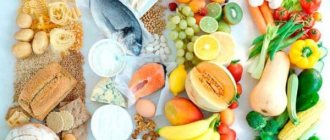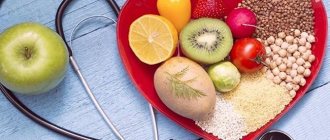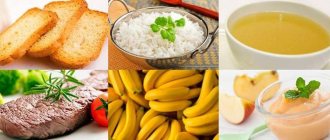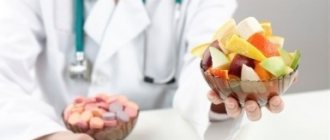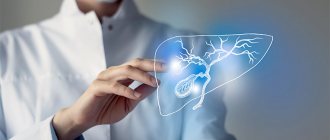Medical editor: Zemereva N.Yu., physiotherapist June, 2021.
Fatty hepatosis refers to liver diseases and is characterized by fatty degeneration of liver cells (accumulation of lipids in liver cells).
The causes of the development of the disease are poor nutrition, taking medications, addiction to alcohol, intoxication and excess body weight. But vegetarianism is often the cause of the disease.
The process is reversible provided that harmful factors are identified and eliminated, including following a diet.
General rules
Fatty hepatosis (liver steatosis, steatohepatosis) is a chronic liver disease characterized by histopathological changes in liver tissue in the form of accumulation of fat, mainly triglycerides , in hepatocytes , which in some cases develops into liver inflammation ( steatohepatitis ) and the development of fibrosis ( steatofibrosis ).
Currently, fatty hepatosis of alcoholic and non-alcoholic origin is distinguished. The leading role in the development of fatty hepatosis due to alcohol consumption is played by a toxic product of ethanol metabolism - acetaldehyde , which reduces the activity of enzymes that transport fatty acids into mitochondria, which leads to impaired fat metabolism and the subsequent accumulation of triglycerides in liver cells. The main etiological factors of non-alcoholic hepatosis are combinations of various metabolic risk factors (abdominal obesity , hyperglycemia , hypercholesterolemia , arterial hypertension , type 2 diabetes mellitus ), viral hepatitis , taking certain medications (glucocorticosteroids, methotrexate , tetracycline , amiodarone , tamoxifen , estrogens and others), rapid weight loss/fasting.
Due to the high risk of developing liver fibrosis and cirrhosis , regardless of the severity of the disease, all patients with fatty hepatosis require treatment and follow-up. However, there is no standardized therapeutic approach to the management of such patients, as well as a clear understanding of how to treat fatty liver hepatosis.
Nutritional treatment (diet limiting easily digestible carbohydrates and fats of animal origin) in combination with lifestyle modification (increasing physical activity, normalizing body weight, giving up bad habits - drinking alcohol/smoking) against the background of hepatoprotective therapy - prescribing antioxidants and hepatoprotectors ( vitamin E , ursodeoxycholic acid , silibinin , betaine , a-lipoic acid ) allows you to achieve a positive result. As a rule, in uncomplicated cases with normal biochemical tests and a known etiology of the disease, regression of fatty liver is observed after 4-6 months.
Therapeutic nutrition for fatty liver hepatosis in patients with increased body weight/ obesity should, first of all, be aimed at its normalization. For this purpose, a hypocaloric diet is prescribed with individual selection of the energy value of the diet depending on age, body weight, level of physical activity, and gender. For this purpose, special formulas are used to calculate the calories required to maintain basal metabolism, which are multiplied by the coefficient of physical activity, which is the calorie level of the daily diet. From this calculated value, 500-700 kcal are subtracted to reduce body weight.
However, at the same time, the minimum daily ration should not be less than 1500 kcal/for men and 1200 kcal for women. Patients should be cautioned against attempting rapid weight loss, since rapid weight loss can lead to the development of “acute” steatohepatitis with the formation of fibrosis against the background of an inflammatory process caused by an increase in the supply of free fatty acids to the liver against a background of relatively low peripheral lipolysis.
The guideline for safe/effective weight loss is: 1500 g/week for adults and 500 g for children. Patients with severe obesity (excess body weight by more than 20% of normal) are prescribed therapeutic Diet No. 8 according to Pevzner. The correlation of a decrease in body weight by 5-10% with regression of fatty liver hepatosis has been reliably confirmed. The diet for fatty hepatosis includes:
- Limit dietary fat to 30% of the total calorie intake.
- The ratio of polyunsaturated/saturated fatty acids in the diet should be more than 1, which is achieved by excluding solid animal fat, butter, fatty meat from the diet and increasing foods containing polyunsaturated fatty acids (seafood, unrefined vegetable oil, nuts, sea/river fish, dietary meat birds, olives);
- reducing the consumption of foods containing large amounts of cholesterol (no more than 300 mg/day). For this purpose, by-products (liver, kidneys), egg yolk, red caviar, fatty meats, dairy products, and smoked foods are excluded from the diet.
- Elimination of such methods of culinary food processing as frying and deep-frying.
- Enriching the diet with vitamins and prebiotic foods (vegetables/fruits, artichoke, Jerusalem artichoke, leeks).
- For patients with diabetes and impaired glucose tolerance, simple carbohydrates are excluded from the diet and complex carbohydrates are limited, which helps improve metabolism.
Treatment of fatty hepatosis of alcoholic etiology requires additional prescription to the basic therapy of water-soluble vitamins PP , B1 , B6 , C , B2 , B12 , administered parenterally in standard therapeutic doses for 2 weeks.
The nutrition of patients with normal body weight should be based on treatment table No. 5 and its variations, which provide for the unloading of fat/cholesterol metabolism and stimulation of the intestines. The diet contains 100 g of proteins, 400 g of carbohydrates, and the fat content is reduced to 75-80 g (mostly refractory).
Excluded are products rich in purines, cholesterol , nitrogenous extractives, essential oils, oxalic acid and fat oxidation by-products formed during frying/deep-frying.
The diet has an increased content of pectins , lipotropic substances, fiber, and free liquid. Methods of culinary processing of products - boiling, baking, stewing. Avoid fatty meats/fish, smoked meats, canned food, sausages, broths, legumes and vegetables containing large quantities of essential oils - all types of radishes/radishes, raw garlic and onions, hot spices, marinades, spices and sauces, vinegar. , full-fat milk/cream, pastries, pies, baked goods.
In addition to permitted foods, your diet should include foods that improve liver function:
- Artichoke - lowers cholesterol levels/normalizes bile flow.
- Leafy greens, vegetables and fruits. Pumpkin and dishes based on it, pumpkin juice are especially useful. It is well absorbed and relieves the liver.
- Vegetables (carrots, beets, bell peppers) are rich in beta-carotene, from which vitamin A .
- cabbage improves the detoxification function of the liver.
- fruits (rose hips, black currants, citrus fruits) - contain large quantities of antioxidants that stop the processes of oxidation and cell damage.
- Cereals (oatmeal/buckwheat) contain vitamins B and PP , which are important for liver function.
- Cold pressed vegetable oils, nuts. They contain large quantities of antioxidants - vitamin E and omega-3 acids, which protect cell membranes from death.
- Dried fruits, especially dried apricots, contain potassium and magnesium.
- Fermented milk products with low fat content (natural yogurt, kefir, acidophilus, fermented baked milk). They normalize the intestinal biocenosis, and cottage cheese is rich in lipotropic substances.
- Honey - promotes the restoration of hepatocytes and activates the production of bile.
- Free liquid in an amount of at least 1.5-2 l/day from which toxins . The detoxification abilities of the liver and its self-cleaning processes are improved by adding citrus fruit juice to the water.
Risk factors for the development of steatosis 1.3
- Obesity or overweight, with a body mass index of 25 or higher
- Type 2 diabetes mellitus or decreased insulin sensitivity
- Lipid metabolism disorders, in particular dyslipidemia
- Metabolic syndrome
- Age 30 – 59 years
- Physical inactivity
- Binge eating
Authorized Products
The diet for liver hepatosis includes inclusion in the diet:
- Vegetable broths and soups based on them with the addition of cereals, noodles, and vegetables.
- Low-fat varieties of red meat (beef/veal), rabbit, chicken, turkey. The meat must be pre-boiled followed by cooking.
- Day-old/dried wheat bread up to 500 g per day. If well tolerated - rye bread, low-fat cookies, dry biscuit.
- Low-fat types of sea/river fish, baked with vegetables.
- Cereals in the form of casseroles, porridge.
- Low-fat fermented milk products: yogurt, kefir, bifidum-kefir, acidophilus and low-fat cottage cheese.
- Milk/sour cream only as an additive to prepared dishes.
- Chicken eggs in the form of a steam omelet/soft-boiled.
- Fresh, baked and stewed vegetables in the form of salads with the addition of vegetable oil, mashed potatoes and homemade squash caviar. Spices include garden herbs, cumin, bay leaf.
- Sour cream, milk and vegetable sauces.
- Non-acidic fruits/berries in fresh and processed form (jelly, compotes, mousses).
- Marmalade, honey, caramel, marshmallows, jams, toffee. Sugar is partially replaced with xylitol.
- Butter/vegetable oil is added only to ready-made dishes; heat treatment is excluded.
- Still table water, rosehip infusion, weak tea, vegetable juices, wheat bran decoction, coffee with milk (not strong).
Table of permitted products
| Proteins, g | Fats, g | Carbohydrates, g | Calories, kcal | |
Vegetables and greens | ||||
| zucchini | 0,6 | 0,3 | 4,6 | 24 |
| broccoli | 3,0 | 0,4 | 5,2 | 28 |
| cauliflower | 2,5 | 0,3 | 5,4 | 30 |
| potato | 2,0 | 0,4 | 18,1 | 80 |
| carrot | 1,3 | 0,1 | 6,9 | 32 |
| pumpkin | 1,3 | 0,3 | 7,7 | 28 |
Fruits | ||||
| apricots | 0,9 | 0,1 | 10,8 | 41 |
| quince | 0,6 | 0,5 | 9,8 | 40 |
| watermelon | 0,6 | 0,1 | 5,8 | 25 |
| bananas | 1,5 | 0,2 | 21,8 | 95 |
| pears | 0,4 | 0,3 | 10,9 | 42 |
| melon | 0,6 | 0,3 | 7,4 | 33 |
| kiwi | 1,0 | 0,6 | 10,3 | 48 |
| peaches | 0,9 | 0,1 | 11,3 | 46 |
| plums | 0,8 | 0,3 | 9,6 | 42 |
| persimmon | 0,5 | 0,3 | 15,3 | 66 |
| apples | 0,4 | 0,4 | 9,8 | 47 |
Berries | ||||
| strawberry | 0,8 | 0,4 | 7,5 | 41 |
| blueberry | 1,1 | 0,4 | 7,6 | 44 |
Nuts and dried fruits | ||||
| raisin | 2,9 | 0,6 | 66,0 | 264 |
| dried figs | 3,1 | 0,8 | 57,9 | 257 |
| dried apricots | 5,2 | 0,3 | 51,0 | 215 |
| dried apricots | 5,0 | 0,4 | 50,6 | 213 |
| prunes | 2,3 | 0,7 | 57,5 | 231 |
Cereals and porridges | ||||
| buckwheat (kernel) | 12,6 | 3,3 | 62,1 | 313 |
| semolina | 10,3 | 1,0 | 73,3 | 328 |
| oat groats | 12,3 | 6,1 | 59,5 | 342 |
| pearl barley | 9,3 | 1,1 | 73,7 | 320 |
| rice | 6,7 | 0,7 | 78,9 | 344 |
Flour and pasta | ||||
| pasta | 10,4 | 1,1 | 69,7 | 337 |
| buckwheat noodles | 14,7 | 0,9 | 70,5 | 348 |
Bakery products | ||||
| wheat bread | 8,1 | 1,0 | 48,8 | 242 |
Confectionery | ||||
| jam | 0,3 | 0,2 | 63,0 | 263 |
| jelly | 2,7 | 0,0 | 17,9 | 79 |
| marshmallows | 0,8 | 0,0 | 78,5 | 304 |
| fruit and berry marmalade | 0,4 | 0,0 | 76,6 | 293 |
| paste | 0,5 | 0,0 | 80,8 | 310 |
Raw materials and seasonings | ||||
| honey | 0,8 | 0,0 | 81,5 | 329 |
| sugar | 0,0 | 0,0 | 99,7 | 398 |
Dairy | ||||
| kefir 1.5% | 3,3 | 1,5 | 3,6 | 41 |
| curdled milk 1% | 3,0 | 1,0 | 4,1 | 40 |
| acidophilus 1% | 3,0 | 1,0 | 4,0 | 40 |
Cheeses and cottage cheese | ||||
| cottage cheese 1% | 16,3 | 1,0 | 1,3 | 79 |
| cottage cheese 1.8% (low-fat) | 18,0 | 1,8 | 3,3 | 101 |
Meat products | ||||
| beef | 18,9 | 19,4 | 0,0 | 187 |
| rabbit | 21,0 | 8,0 | 0,0 | 156 |
Bird | ||||
| boiled chicken breast | 29,8 | 1,8 | 0,5 | 137 |
| boiled chicken drumstick | 27,0 | 5,6 | 0,0 | 158 |
| boiled turkey fillet | 25,0 | 1,0 | — | 130 |
Eggs | ||||
| chicken eggs | 12,7 | 10,9 | 0,7 | 157 |
Fish and seafood | ||||
| flounder | 16,5 | 1,8 | 0,0 | 83 |
| pollock | 15,9 | 0,9 | 0,0 | 72 |
| cod | 17,7 | 0,7 | — | 78 |
| hake | 16,6 | 2,2 | 0,0 | 86 |
Oils and fats | ||||
| butter | 0,5 | 82,5 | 0,8 | 748 |
| sunflower oil | 0,0 | 99,9 | 0,0 | 899 |
Non-alcoholic drinks | ||||
| water | 0,0 | 0,0 | 0,0 | — |
| mineral water | 0,0 | 0,0 | 0,0 | — |
Juices and compotes | ||||
| apricot juice | 0,9 | 0,1 | 9,0 | 38 |
| carrot juice | 1,1 | 0,1 | 6,4 | 28 |
| peach juice | 0,9 | 0,1 | 9,5 | 40 |
| pumpkin juice | 0,0 | 0,0 | 9,0 | 38 |
| rose hip juice | 0,1 | 0,0 | 17,6 | 70 |
| * data is per 100 g of product | ||||
Why do you need a diet for liver disease?
If you use only medications, is it possible to normalize liver function? Experts believe that without following a diet, it will not be possible to quickly restore the cells of an important organ.
The diet is necessary for the following reasons:
- you need to remove the load from the diseased organ;
- provide the body with necessary vitamins and minerals;
- add a number of elements that will increase the rate of liver cell regeneration;
- will save from exacerbation of the disease, deterioration of the victim’s condition.
A proper diet is part of a mandatory set of measures to restore health.
Fully or partially limited products
The diet for liver hepatosis includes the following exceptions:
- Broths based on meat/fish and mushrooms, as well as first courses based on them.
- Fatty meat and fatty varieties of sea/river fish, meat of domestic waterfowl (goose and duck), smoked meats, sausages, salted fish.
- Products containing flavoring additives, preservatives, confectionery products with a long shelf life, freeze-dried products.
- Offal (liver, kidneys, brains), cooking/animal fat.
- Legumes and vegetables containing coarse fiber (radish, radish, turnip, white cabbage).
- Products rich in oxalic acid/essential oils (sour sauerkraut, sorrel, garlic, onion, spinach).
- Fried/hard-boiled eggs.
- Hot spices/herbs (horseradish, pepper, mayonnaise, mustard, ketchup).
- Heavy cream/milk, full-fat cottage cheese, chocolate, cakes, cheese curds, puff pastry, coffee, cocoa, cakes, muffins.
- Sour berries/fruits.
- Alcohol-containing and carbonated sweet drinks, and mineral waters.
Table of prohibited products
| Proteins, g | Fats, g | Carbohydrates, g | Calories, kcal | |
Vegetables and greens | ||||
| canned vegetables | 1,5 | 0,2 | 5,5 | 30 |
| eggplant | 1,2 | 0,1 | 4,5 | 24 |
| swede | 1,2 | 0,1 | 7,7 | 37 |
| peas | 6,0 | 0,0 | 9,0 | 60 |
| bulb onions | 1,4 | 0,0 | 10,4 | 41 |
| chickpeas | 19,0 | 6,0 | 61,0 | 364 |
| cucumbers | 0,8 | 0,1 | 2,8 | 15 |
| salad pepper | 1,3 | 0,0 | 5,3 | 27 |
| parsley | 3,7 | 0,4 | 7,6 | 47 |
| radish | 1,2 | 0,1 | 3,4 | 19 |
| white radish | 1,4 | 0,0 | 4,1 | 21 |
| iceberg lettuce | 0,9 | 0,1 | 1,8 | 14 |
| tomatoes | 0,6 | 0,2 | 4,2 | 20 |
| dill | 2,5 | 0,5 | 6,3 | 38 |
| beans | 7,8 | 0,5 | 21,5 | 123 |
| horseradish | 3,2 | 0,4 | 10,5 | 56 |
| spinach | 2,9 | 0,3 | 2,0 | 22 |
| sorrel | 1,5 | 0,3 | 2,9 | 19 |
Berries | ||||
| grape | 0,6 | 0,2 | 16,8 | 65 |
Mushrooms | ||||
| mushrooms | 3,5 | 2,0 | 2,5 | 30 |
| marinated mushrooms | 2,2 | 0,4 | 0,0 | 20 |
Nuts and dried fruits | ||||
| nuts | 15,0 | 40,0 | 20,0 | 500 |
| peanut | 26,3 | 45,2 | 9,9 | 551 |
| seeds | 22,6 | 49,4 | 4,1 | 567 |
Cereals and porridges | ||||
| millet cereal | 11,5 | 3,3 | 69,3 | 348 |
Flour and pasta | ||||
| pasta | 10,4 | 1,1 | 69,7 | 337 |
| dumplings | 11,9 | 12,4 | 29,0 | 275 |
Bakery products | ||||
| buns | 7,9 | 9,4 | 55,5 | 339 |
| Rye bread | 6,6 | 1,2 | 34,2 | 165 |
Confectionery | ||||
| pastry cream | 0,2 | 26,0 | 16,5 | 300 |
| shortbread dough | 6,5 | 21,6 | 49,9 | 403 |
Ice cream | ||||
| ice cream | 3,7 | 6,9 | 22,1 | 189 |
Chocolate | ||||
| chocolate | 5,4 | 35,3 | 56,5 | 544 |
Raw materials and seasonings | ||||
| mustard | 5,7 | 6,4 | 22,0 | 162 |
| mayonnaise | 2,4 | 67,0 | 3,9 | 627 |
Dairy | ||||
| milk 4.5% | 3,1 | 4,5 | 4,7 | 72 |
| cream 35% (fat) | 2,5 | 35,0 | 3,0 | 337 |
| whipped cream | 3,2 | 22,2 | 12,5 | 257 |
| sour cream 30% | 2,4 | 30,0 | 3,1 | 294 |
Cheeses and cottage cheese | ||||
| parmesan cheese | 33,0 | 28,0 | 0,0 | 392 |
Meat products | ||||
| fatty pork | 11,4 | 49,3 | 0,0 | 489 |
| salo | 2,4 | 89,0 | 0,0 | 797 |
| bacon | 23,0 | 45,0 | 0,0 | 500 |
Sausages | ||||
| smoked sausage | 9,9 | 63,2 | 0,3 | 608 |
Bird | ||||
| smoked chicken | 27,5 | 8,2 | 0,0 | 184 |
| duck | 16,5 | 61,2 | 0,0 | 346 |
| smoked duck | 19,0 | 28,4 | 0,0 | 337 |
| goose | 16,1 | 33,3 | 0,0 | 364 |
Fish and seafood | ||||
| smoked fish | 26,8 | 9,9 | 0,0 | 196 |
| black caviar | 28,0 | 9,7 | 0,0 | 203 |
| salmon caviar granular | 32,0 | 15,0 | 0,0 | 263 |
| salmon | 19,8 | 6,3 | 0,0 | 142 |
| canned fish | 17,5 | 2,0 | 0,0 | 88 |
| salmon | 21,6 | 6,0 | — | 140 |
| trout | 19,2 | 2,1 | — | 97 |
Oils and fats | ||||
| animal fat | 0,0 | 99,7 | 0,0 | 897 |
| cooking fat | 0,0 | 99,7 | 0,0 | 897 |
Alcoholic drinks | ||||
| dry red wine | 0,2 | 0,0 | 0,3 | 68 |
| vodka | 0,0 | 0,0 | 0,1 | 235 |
| beer | 0,3 | 0,0 | 4,6 | 42 |
Non-alcoholic drinks | ||||
| soda water | 0,0 | 0,0 | 0,0 | — |
| cola | 0,0 | 0,0 | 10,4 | 42 |
| instant coffee dry | 15,0 | 3,5 | 0,0 | 94 |
| sprite | 0,1 | 0,0 | 7,0 | 29 |
| * data is per 100 g of product | ||||
General nutrition rules
The diet includes a number of rules that must be followed. The menu should be adjusted, foods that worsen the patient’s condition should be removed.
Recommendations for catering:
- It is prohibited to consume chilled foods;
- avoid hot and cold foods, eat only warm foods;
- reduce the amount of carbohydrates;
- the temperature of the drinks should be 35-40°C
- organize five meals a day;
- If possible, reduce the amount of salt consumed, the permissible amount is 7 g per day;
- increase the amount of vegetables in the menu;
- you can’t eat fried food;
- do not eat anything fatty;
- Smoked and pickled products are not allowed.
It is important to prepare foods correctly and not to eat fried foods, which are harmful to the patient’s condition.
Reviews and results
Medical nutrition is the main component of the treatment of patients with fatty hepatosis, allowing to maintain the general condition and prevent the progression of the process, and in the initial stages of the disease - to achieve regression of fatty hepatosis and normalization of liver function.
- “...I was diagnosed with fatty liver hepatosis a year after suffering from viral hepatitis. They prescribed a diet and hepaprotectors. I followed a strict diet for almost 6 months, completely eliminated alcohol, and started working out at the gym. Now my health has improved significantly, my appetite has returned to normal and my blood tests are almost normal. But I don’t want to relax and I’ll go on a diet for another 2-3 months, and maybe I’ll even eat like this all the time, since eating like this doesn’t bother me”;
- “... Fatty liver hepatosis was discovered during an examination for cholelithiasis. After surgery to remove the stones, I decided to tackle the problem of fatty hepatosis. As I was told, there are no special medications for treatment. That's why they recommended a diet. To begin with, I was on a low-calorie diet for almost 6 months, limiting fats and carbohydrates, until my weight was more or less close to normal, since at a normal weight of 72 kg I weighed 98 kg. Then I switched to dietary Table No. 5 and now I’ve been on a diet for almost a year. It’s quite easy to tolerate, and since there are positive changes, it’s inspiring and I want to bring the liver back to normal completely.”
Symptoms
The main danger of the disease is that it does not manifest itself for a long time.
There are no specific symptoms of liver damage, which is why the person is not even aware of the slowly progressing changes. Fatty hepatosis can develop for years without any manifestations, and the clinic appears only when complications develop, when treatment becomes difficult, and changes in the liver become irreversible. Nonspecific symptoms of fatty hepatosis, which can appear with significant structural changes in hepatocytes:
- Discomfort or periodic nagging pain in the right hypochondrium;
- Nausea, vomiting, stool disorders;
- Slight yellowness of the mucous membranes (visible on the whites of the eyes) and skin;
- General condition of asthenia, weakness.
With diffuse liver damage, periodic attacks of low blood pressure and fainting may develop. A person may also have symptoms specific to the underlying disease. For example, heart pain due to coronary heart disease. Or thirst, weight loss, polyuria, characteristic of diabetes.
Recipes for dietary dishes for liver disease
It is necessary to pay attention that the diet when the liver hurts fully complies with the recommendations of the attending physician.
First course
For the basis of the first course, it is allowed to use decoctions of vegetables and fruits. Cream is suitable for dressing; frying in oil or fat is unacceptable. It is recommended to add dill and parsley.
Allowed soups:
- cereals;
- dairy;
- from fresh tomatoes.
Beetroot recipe.
List of ingredients:
- beet broth – 300 ml;
- beets – 150 g;
- cucumbers – 75 g;
- lettuce leaf – 10 g;
- sour cream – 2 tablespoons;
- sugar – 10 g;
- boiled egg white – 1 pc.;
- dill greens.
Cooking technology:
- Boil clean beets. Remove the vegetable from the pan and peel.
- Strain the broth.
- Grind the beets, put them in liquid, add sugar.
- Cut cucumbers, whites, add to beetroot soup.
- Use sour cream as a dressing.
- Chop the greens and put them on a plate.
You can add boiled potatoes. Beetroot soup with fresh apples turns out delicious.
